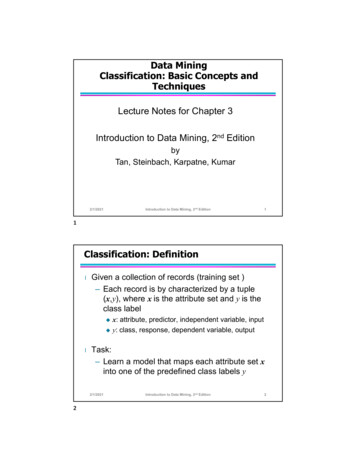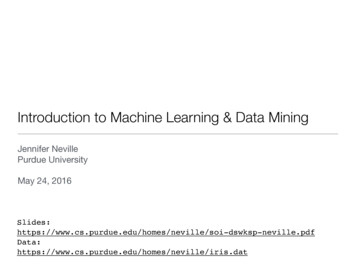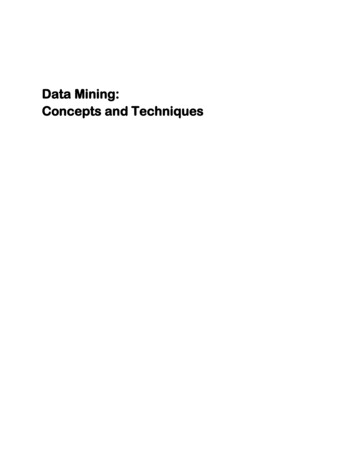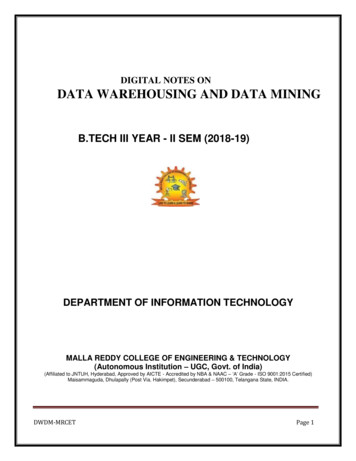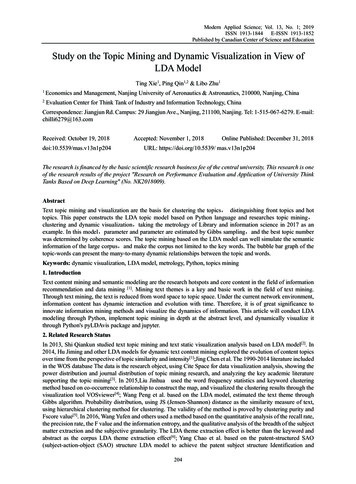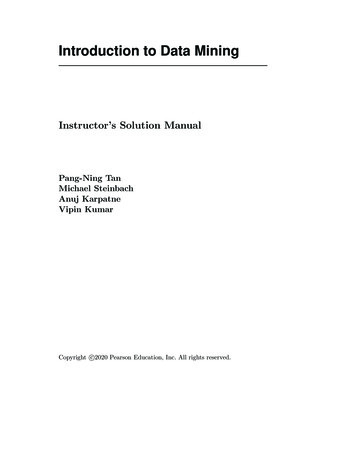
Transcription
Data Mining:Concepts and Techniques— Chapter 2 —2nd Edition, Han and Kamber[Note: Materials of this presentation are from Chapter 2, 2nd Edition of textbook,unless mentioned otherwise)Jiawei HanDepartment of Computer ScienceUniversity of Illinois at Urbana-Champaignwww.cs.uiuc.edu/ hanj 2006 Jiawei Han and Micheline Kamber, All rights reservedFebruary 19, 2008Data Mining: Concepts and Techniques1
February 19, 2008Data Mining: Concepts and Techniques2
Chapter 2: Data Preprocessing Why preprocess the data? Descriptive data summarization (Ch. 2.1, 3 Data cleaning Data integration and transformation Data reduction Discretization and concept hierarchy generation SummaryFebruary 19, 2008Data Mining: Concepts and TechniquesrdEdition, textbook)3
Why Data Preprocessing? Data in the real world is dirty incomplete: lacking attribute values, lackingcertain attributes of interest, or containingonly aggregate data noisy: containing errors or outliers e.g., occupation “ ”e.g., Salary “-10”inconsistent: containing discrepancies in codesor names February 19, 2008e.g., Age “42” Birthday “03/07/1997”e.g., Was rating “1,2,3”, now rating “A, B, C”e.g., discrepancy between duplicate recordsData Mining: Concepts and Techniques4
Why Is Data Dirty? Incomplete data may come from Noisy data (incorrect values) may come from Faulty data collection instrumentsHuman or computer error at data entryErrors in data transmissionInconsistent data may come from “Not applicable” data value when collectedDifferent considerations between the time when the data wascollected and when it is analyzed.Human/hardware/software problemsDifferent data sourcesFunctional dependency violation (e.g., modify some linked data)Duplicate records also need data cleaningFebruary 19, 2008Data Mining: Concepts and Techniques5
Why Is Data Preprocessing Important? No quality data, no quality mining results! Quality decisions must be based on quality data e.g., duplicate or missing data may cause incorrect or evenmisleading statistics.Data warehouse needs consistent integration of qualitydataData extraction, cleaning, and transformation comprisesthe majority of the work of building a data warehouseFebruary 19, 2008Data Mining: Concepts and Techniques6
Multi-Dimensional Measure of Data Quality A well-accepted multidimensional view: Accuracy Completeness Consistency Timeliness Believability Value added Interpretability AccessibilityBroad categories: Intrinsic, contextual, representational, and accessibilityFebruary 19, 2008Data Mining: Concepts and Techniques7
Major Tasks in Data Preprocessing Data cleaning Data integration Normalization and aggregationData reduction Integration of multiple databases, data cubes, or filesData transformation Fill in missing values, smooth noisy data, identify or removeoutliers, and resolve inconsistenciesObtains reduced representation in volume but produces the sameor similar analytical resultsData discretization Part of data reduction but with particular importance, especiallyfor numerical dataFebruary 19, 2008Data Mining: Concepts and Techniques8
Forms of Data PreprocessingFebruary 19, 2008Data Mining: Concepts and Techniques9
Chapter 2: Data Preprocessing Why preprocess the data? Descriptive data summarization Data cleaning Data integration and transformation Data reduction Discretization and concept hierarchy generation SummaryFebruary 19, 2008Data Mining: Concepts and Techniques10
Mining Data Descriptive Characteristics Motivation Data dispersion characteristics median, max, min, quantiles, outliers, variance, etc.Numerical dimensions correspond to sorted intervals To better understand the data: central tendency, variation andspreadData dispersion: analyzed with multiple granularities ofprecisionBoxplot or quantile analysis on sorted intervalsDispersion analysis on computed measures Folding measures into numerical dimensions Boxplot or quantile analysis on the transformed cubeFebruary 19, 2008Data Mining: Concepts and Techniques11
Measuring the Central Tendency Mean (algebraic measure) (sample vs. population):xnni Weighted arithmetic mean: Trimmed mean: chopping extreme valuesx1xμiNnw xxii1inwMedian: A holistic measure 1i1iMiddle value if odd number of values, or average of the middle twovalues otherwiseEstimated by interpolation (for grouped data):median LMode1 Value that occurs most frequently in the data Unimodal, bimodal, trimodal Empirical formula:February 19, 2008mean mode 3Data Mining: Concepts and Techniquesn 2f lfcmedianmean median12
Symmetric vs. Skewed Data Median, mean and mode ofsymmetric, positively andnegatively skewed dataFebruary 19, 2008Data Mining: Concepts and Techniques13
Measuring the Dispersion of DataQuartiles, outliers and boxplots Quartiles: Q1 (25th percentile), Q3 (75th percentile) Inter-quartile range: IQR Q3 – Q1 Five number summary: min, Q1, M, Q3, max Boxplot: ends of the box are the quartiles, median is marked, whiskers, andplot outlier individuallyOutlier: usually, a value higher/lower than 1.5 x IQR Variance and standard deviation (sample: s, population: σ) Variance: (algebraic, scalable computation) n12sxn 1i 1ix21n 1nxi 1i12nnxi 1i2σ21nNi 1x μi21nx μ2N i 1 i2Standard deviation s (or σ) is the square root of variance s2 (or σ2)February 19, 2008Data Mining: Concepts and Techniques14
Properties of Normal Distribution Curve The normal (distribution) curve From μ–σ to μ σ: contains about 68% of themeasurements (μ: mean, σ: standard deviation) From μ–2σ to μ 2σ: contains about 95% of it From μ–3σ to μ 3σ: contains about 99.7% of itFebruary 19, 2008Data Mining: Concepts and Techniques15
Boxplot Analysis Five-number summary of a distribution:Minimum, Q1, M, Q3, Maximum Boxplot Data is represented with a boxThe ends of the box are at the first and thirdquartiles, i.e., the height of the box is IRQThe median is marked by a line within the boxWhiskers: two lines outside the box extend toMinimum and MaximumFebruary 19, 2008Data Mining: Concepts and Techniques16
Visualization of Data Dispersion: Boxplot AnalysisFebruary 19, 2008Data Mining: Concepts and Techniques17
Histogram Analysis Graph displays of basic statistical class descriptions Frequency histograms February 19, 2008A univariate graphical methodConsists of a set of rectangles that reflect the counts orfrequencies of the classes present in the given dataData Mining: Concepts and Techniques18
Quantile Plot Displays all of the data (allowing the user to assess boththe overall behavior and unusual occurrences)Plots quantile information For a data xi data sorted in increasing order, fi indicatesthat approximately 100 fi% of the data are below orequal to the value xiFebruary 19, 2008Data Mining: Concepts and Techniques19
Quantile-Quantile (Q-Q) Plot Graphs the quantiles of one univariate distribution againstthe corresponding quantiles of anotherAllows the user to view whether there is a shift in goingfrom one distribution to anotherFebruary 19, 2008Data Mining: Concepts and Techniques20
Scatter plot Provides a first look at bivariate data to see clusters ofpoints, outliers, etcEach pair of values is treated as a pair of coordinates andplotted as points in the planeFebruary 19, 2008Data Mining: Concepts and Techniques21
Loess Curve Adds a smooth curve to a scatter plot in order toprovide better perception of the pattern of dependenceLoess curve is fitted by setting two parameters: asmoothing parameter, and the degree of thepolynomials that are fitted by the regressionFebruary 19, 2008Data Mining: Concepts and Techniques22
Positively and Negatively Correlated DataFebruary 19, 2008Data Mining: Concepts and Techniques23
Not Correlated DataFebruary 19, 2008Data Mining: Concepts and Techniques24
Graphic Displays of Basic Statistical Descriptions Histogram: (shown before)Boxplot: (covered before)Quantile plot: each value xi is paired with fi indicatingthat approximately 100 fi % of data are xiQuantile-quantile (q-q) plot: graphs the quantiles of oneunivariant distribution against the corresponding quantilesof anotherScatter plot: each pair of values is a pair of coordinatesand plotted as points in the planeLoess (local regression) curve: add a smooth curve to ascatter plot to provide better perception of the pattern ofdependenceFebruary 19, 2008Data Mining: Concepts and Techniques25
Chapter 2: Data Preprocessing Why preprocess the data? Descriptive data summarization Data cleaning Data integration and transformation Data reduction Discretization and concept hierarchy generation SummaryFebruary 19, 2008Data Mining: Concepts and Techniques26
Data Cleaning Importance “Data cleaning is one of the three biggest problemsin data warehousing”—Ralph Kimball “Data cleaning is the number one problem in datawarehousing”—DCI surveyData cleaning tasks Fill in missing values Identify outliers and smooth out noisy data Correct inconsistent data Resolve redundancy caused by data integrationFebruary 19, 2008Data Mining: Concepts and Techniques27
Missing Data Data is not always available Missing data may be due to equipment malfunction inconsistent with other recorded data and thus deleted data not entered due to misunderstanding E.g., many tuples have no recorded value for severalattributes, such as customer income in sales datacertain data may not be considered important at the time ofentrynot register history or changes of the dataMissing data may need to be inferred.February 19, 2008Data Mining: Concepts and Techniques28
How to Handle Missing Data? Ignore the tuple: usually done when class label is missing (assumingthe tasks in classification—not effective when the percentage ofmissing values per attribute varies considerably. Fill in the missing value manually: tedious infeasible? Fill in it automatically with a global constant : e.g., “unknown”, a new class?! the attribute mean the attribute mean for all samples belonging to the same class:smarter the most probable value: inference-based such as Bayesianformula or decision treeFebruary 19, 2008Data Mining: Concepts and Techniques29
Noisy Data Noise: random error or variance in a measured variableIncorrect attribute values may due to faulty data collection instruments data entry problems data transmission problems technology limitation inconsistency in naming conventionOther data problems which requires data cleaning duplicate records incomplete data inconsistent dataFebruary 19, 2008Data Mining: Concepts and Techniques30
How to Handle Noisy Data? Binning first sort data and partition into (equal-frequency) bins then one can smooth by bin means, smooth by binmedian, smooth by bin boundaries, etc.Regression smooth by fitting the data into regression functionsClustering detect and remove outliersCombined computer and human inspection detect suspicious values and check by human (e.g.,deal with possible outliers)February 19, 2008Data Mining: Concepts and Techniques31
Simple Discretization Methods: Binning Equal-width (distance) partitioning Divides the range into N intervals of equal size: uniform grid if A and B are the lowest and highest values of the attribute, thewidth of intervals will be: W (B –A)/N. The most straightforward, but outliers may dominate presentation Skewed data is not handled wellEqual-depth (frequency) partitioning Divides the range into N intervals, each containing approximatelysame number of samples Good data scaling Managing categorical attributes can be trickyFebruary 19, 2008Data Mining: Concepts and Techniques32
Binning Methods for Data SmoothingSorted data for price (in dollars): 4, 8, 9, 15, 21, 21, 24, 25, 26,28, 29, 34* Partition into equal-frequency (equi-depth) bins:- Bin 1: 4, 8, 9, 15- Bin 2: 21, 21, 24, 25- Bin 3: 26, 28, 29, 34* Smoothing by bin means:- Bin 1: 9, 9, 9, 9- Bin 2: 23, 23, 23, 23- Bin 3: 29, 29, 29, 29* Smoothing by bin boundaries:- Bin 1: 4, 4, 4, 15- Bin 2: 21, 21, 25, 25- Bin 3: 26, 26, 26, 34 February 19, 2008Data Mining: Concepts and Techniques33
RegressionyY1Y1’y x 1X1February 19, 2008Data Mining: Concepts and Techniquesx34
Data Mining: Concepts and Techniques
Data Cleaning as a Process Data discrepancy detection Use metadata (e.g., domain, range, dependency, distribution) Check field overloading Check uniqueness rule, consecutive rule and null rule Use commercial tools Data scrubbing: use simple domain knowledge (e.g., postalcode, spell-check) to detect errors and make corrections Data auditing: by analyzing data to discover rules andrelationship to detect violators (e.g., correlation and clusteringto find outliers)Data migration and integration Data migration tools: allow transformations to be specified ETL (Extraction/Transformation/Loading) tools: allow users tospecify transformations through a graphical user interfaceIntegration of the two processes Iterative and interactive (e.g., Potter’s Wheels)February 19, 2008Data Mining: Concepts and Techniques36
Chapter 2: Data Preprocessing Why preprocess the data? Data cleaning Data integration and transformation Data reduction Discretization and concept hierarchy generation SummaryFebruary 19, 2008Data Mining: Concepts and Techniques37
Data Integration Data integration: Combines data from multiple sources into a coherentstoreSchema integration: e.g., A.cust-id B.cust-# Integrate metadata from different sourcesEntity identification problem: Identify real world entities from multiple data sources,e.g., Bill Clinton William ClintonDetecting and resolving data value conflicts For the same real world entity, attribute values fromdifferent sources are different Possible reasons: different representations, differentscales, e.g., metric vs. British unitsFebruary 19, 2008Data Mining: Concepts and Techniques38
Handling Redundancy in Data Integration Redundant data occur often when integration of multipledatabases Object identification: The same attribute or objectmay have different names in different databases Derivable data: One attribute may be a “derived”attribute in another table, e.g., annual revenue Redundant attributes may be able to be detected bycorrelation analysis Careful integration of the data from multiple sources mayhelp reduce/avoid redundancies and inconsistencies andimprove mining speed and qualityFebruary 19, 2008Data Mining: Concepts and Techniques39
Correlation Analysis (Numerical Data) Correlation coefficient (also called Pearson’s productmoment coefficient)rAABBA,Bn 1 σAσAB nABBn 1 σAσBwhere n is the number of tuples, A and B are the respectivemeans of A and B, σA and σB are the respective standard deviationof A and B, and Σ(AB) is the sum of the AB cross-product. If rA,B 0, A and B are positively correlated (A’s valuesincrease as B’s). The higher, the stronger correlation.rA,B 0: independent; rA,B 0: negatively correlatedFebruary 19, 2008Data Mining: Concepts and Techniques40
Correlation Analysis (Categorical Data) Χ2 (chi-square) testχ 2Observed Expected2ExpectedThe larger the Χ2 value, the more likely the variables arerelatedThe cells that contribute the most to the Χ2 value arethose whose actual count is very different from theexpected countCorrelation does not imply causality # of hospitals and # of car-theft in a city are correlated Both are causally linked to the third variable: populationFebruary 19, 2008Data Mining: Concepts and Techniques41
Data Mining: Concepts and Techniques
Data Transformation Smoothing: remove noise from dataAggregation: summarization, data cube construction Generalization: concept hierarchy climbing Normalization: scaled to fall within a small, specifiedrange min-max normalization z-score normalization normalization by decimal scalingAttribute/feature construction New attributes constructed from the given onesFebruary 19, 2008Data Mining: Concepts and Techniques43
Data Transformation: Normalization Min-max normalization: to [new minA, new maxA]v'vmin Amax A min Anewmax Anewmin Anewmin AEx. Let income range 12,000 to 98,000 normalized to [0.0,1.0]. Then 73,000 is mapped to 73 ,600 12,000 1.0 0 0 0.71698 ,000 12, 000 Z-score normalization (μ: mean, σ: standard deviation):v μv' σAAEx. Let μ 54,000, σ 16,000. ThenNormalization by decimal scalingv'v10February 19, 2008j73 ,600 54 ,0001.22516 ,000Where j is the smallest integer such that Max( ν’ ) 1Data Mining: Concepts and Techniques44
Chapter 2: Data Preprocessing Why preprocess the data? Data cleaning Data integration and transformation Data reduction Discretization and concept hierarchy generation SummaryFebruary 19, 2008Data Mining: Concepts and Techniques45
Data Reduction Strategies Why data reduction? A database/data warehouse may store terabytes of data Complex data analysis/mining may take a very long time to runon the complete data setData reduction Obtain a reduced representation of the data set that is muchsmaller in volume but yet produce the same (or almost thesame) analytical resultsData reduction strategies Data cube aggregation: Dimensionality reduction — e.g., remove unimportant attributes Data Compression Numerosity reduction — e.g., fit data into models Discretization and concept hierarchy generationFebruary 19, 2008Data Mining: Concepts and Techniques46
Data Cube Aggregation The lowest level of a data cube (base cuboid) The aggregated data for an individual entity of interest E.g., a customer in a phone calling data warehouseMultiple levels of aggregation in data cubes Reference appropriate levels Further reduce the size of data to deal withUse the smallest representation which is enough tosolve the taskQueries regarding aggregated information should beanswered using data cube, when possibleFebruary 19, 2008Data Mining: Concepts and Techniques47
Attribute Subset Selection Feature selection (i.e., attribute subset selection): Select a minimum set of features such that theprobability distribution of different classes given thevalues for those features is as close as possible to theoriginal distribution given the values of all features reduce # of patterns in the patterns, easier tounderstandHeuristic methods (due to exponential # of choices): Step-wise forward selection Step-wise backward elimination Combining forward selection and backward elimination Decision-tree inductionFebruary 19, 2008Data Mining: Concepts and Techniques48
Data Mining: Concepts and Techniques
Heuristic Feature Selection Methods There are 2d possible sub-features of d featuresSeveral heuristic feature selection methods: Best single features under the feature independenceassumption: choose by significance tests Best step-wise feature selection: The best single-feature is picked first Then next best feature condition to the first, . Step-wise feature elimination: Repeatedly eliminate the worst feature Best combined feature selection and elimination Optimal branch and bound: Use feature elimination and backtrackingFebruary 19, 2008Data Mining: Concepts and Techniques50
Data Compression String compression There are extensive theories and well-tuned algorithms Typically lossless But only limited manipulation is possible withoutexpansionAudio/video compression Typically lossy compression, with progressive refinement Sometimes small fragments of signal can bereconstructed without reconstructing the wholeTime sequence is not audio Typically short and vary slowly with timeFebruary 19, 2008Data Mining: Concepts and Techniques51
Data Mining: Concepts and Techniques
Data Mining: Concepts and Techniques
DWT for Image Compression ImageLow PassLow PassLow PassFebruary 19, 2008High PassHigh PassHigh PassData Mining: Concepts and Techniques54
Dimensionality Reduction: PrincipalComponent Analysis (PCA) Given N data vectors from n-dimensions, find k n orthogonal vectors(principal components) that can be best used to represent dataSteps Normalize input data: Each attribute falls within the same range Compute k orthonormal (unit) vectors, i.e., principal components Each input data (vector) is a linear combination of the k principalcomponent vectors The principal components are sorted in order of decreasing“significance” or strength Since the components are sorted, the size of the data can bereduced by eliminating the weak components, i.e., those with lowvariance. (i.e., using the strongest principal components, it ispossible to reconstruct a good approximation of the original dataWorks for numeric data onlyUsed when the number of dimensions is largeFebruary 19, 2008Data Mining: Concepts and Techniques55
Principal Component AnalysisX2Y1Y2X1February 19, 2008Data Mining: Concepts and Techniques56
Numerosity Reduction Reduce data volume by choosing alternative, smallerforms of data representationParametric methods Assume the data fits some model, estimate modelparameters, store only the parameters, and discardthe data (except possible outliers) Example: Log-linear models—obtain value at a pointin m-D space as the product on appropriate marginalsubspacesNon-parametric methods Do not assume models Major families: histograms, clustering, samplingFebruary 19, 2008Data Mining: Concepts and Techniques57
Data Reduction Method (1):Regression and Log-Linear Models Linear regression: Data are modeled to fit a straight line Often uses the least-square method to fit the lineMultiple regression: allows a response variable Y to bemodeled as a linear function of multidimensional featurevector Log-linear model: approximates discretemultidimensional probability distributionsFebruary 19, 2008Data Mining: Concepts and Techniques58
Regress Analysis and Log-Linear Models Linear regression: Y w X b Two regression coefficients, w and b, specify the lineand are to be estimated by using the data at hand Using the least squares criterion to the known valuesof Y1, Y2, , X1, X2, .Multiple regression: Y b0 b1 X1 b2 X2. Many nonlinear functions can be transformed into theaboveLog-linear models: The multi-way table of joint probabilities isapproximated by a product of lower-order tables Probability: p(a, b, c, d) ab ac ad bcdData Mining: Concepts and Techniques
Data Reduction Method (2): Histograms35Partitioning rules:20February 19, 2008Data Mining: Concepts and Techniques1000009000080000MaxDiff: set bucket boundary0between each pair for pairs havethe β–1 largest differences70000V-optimal: with the least15histogram variance (weightedsum of the original values that 10each bucket represents)560000 2550000 Equal-frequency (or equaldepth)40000 Equal-width: equal bucket range3030000 20000 Divide data into buckets and store 40average (sum) for each bucket10000 60
Data Reduction Method (3): Clustering Partition data set into clusters based on similarity, and store clusterrepresentation (e.g., centroid and diameter) only Can be very effective if data is clustered but not if data is “smeared” Can have hierarchical clustering and be stored in multi-dimensionalindex tree structures There are many choices of clustering definitions and clusteringalgorithms Cluster analysis will be studied in depth in Chapter 7February 19, 2008Data Mining: Concepts and Techniques61
Data Reduction Method (4): Sampling Sampling: obtaining a small sample s to represent thewhole data set NAllow a mining algorithm to run in complexity that ispotentially sub-linear to the size of the dataChoose a representative subset of the data Simple random sampling may have very poorperformance in the presence of skewDevelop adaptive sampling methods Stratified sampling: Approximate the percentage of each class (orsubpopulation of interest) in the overall database Used in conjunction with skewed dataNote: Sampling may not reduce database I/Os (page at atime)February 19, 2008Data Mining: Concepts and Techniques62
Data Mining: Concepts and Techniques
Data Mining: Concepts and Techniques
Chapter 2: Data Preprocessing Why preprocess the data? Data cleaning Data integration and transformation Data reduction Discretization and concept hierarchy generation SummaryFebruary 19, 2008Data Mining: Concepts and Techniques65
Discretization Three types of attributes: Nominal — values from an unordered set, e.g., color, profession Ordinal — values from an ordered set, e.g., military or academicrank Continuous — real numbers, e.g., integer or real numbersDiscretization: Divide the range of a continuous attribute into intervals Some classification algorithms only accept categorical attributes. Reduce data size by discretization Prepare for further analysisFebruary 19, 2008Data Mining: Concepts and Techniques66
Discretization and Concept Hierarchy Discretization Reduce the number of values for a given continuous attribute bydividing the range of the attribute into intervals Interval labels can then be used to replace actual data values Supervised vs. unsupervised Split (top-down) vs. merge (bottom-up) Discretization can be performed recursively on an attributeConcept hierarchy formation Recursively reduce the data by collecting and replacing low levelconcepts (such as numeric values for age) by higher level concepts(such as young, middle-aged, or senior)February 19, 2008Data Mining: Concepts and Techniques67
Discretization and Concept HierarchyGeneration for Numeric Data Typical methods: All the methods can be applied recursively Binning (covered above) Histogram analysis (covered above) Top-down split, unsupervised,Top-down split, unsupervisedClustering analysis (covered above) Either top-down split or bottom-up merge, unsupervised Entropy-based discretization: supervised, top-down split Interval merging by 2 Analysis: unsupervised, bottom-up merge Segmentation by natural partitioning: top-down split, unsupervisedFebruary 19, 2008Data Mining: Concepts and Techniques68
Entropy-Based Discretization Given a set of samples S, if S is partitioned into two intervals S 1 and S2using boundary T, the information gain after partitioning isI S, T S1S2Entropy SEntropy SSEntropy is calculated basedS on class distributionof the samples in theset. Given m classes, the entropy of S1 is12mEntropy S1p logiwhere pi is the probability of class i in S1 i12piThe boundary that minimizes the entropy function over all possibleboundaries is selected as a binary discretizationThe process is recursively applied to partitions obtained until somestopping criterion is metSuch a boundary may reduce data size and improve classificationaccuracyFebruary 19, 2008Data Mining: Concepts and Techniques69
Interval Merge by 2 Analysis Merging-based (bottom-up) vs. splitting-based methods Merge: Find the best neighboring intervals and merge them to formlarger intervals recursively ChiMerge [Kerber AAAI 1992, See also Liu et al. DMKD 2002] Initially, each distinct value of a numerical attr. A is considered to beone interval 2 tests are performed for every pair of adjacent intervals Adjacent intervals with the least 2 values are merged together, sincelow 2 values for a pair indicate similar class distributions This merge process proceeds recursively until a predefined stoppingcriterion is met (such as significance level, max-interval, maxinconsistency, etc.)February 19, 2008Data Mining: Concepts and Techniques70
Segmentation by Natural Partitioning A simply 3-4-5 rule can be used to segment numeric datainto relatively uniform, “natural” intervals. If an interval covers 3, 6, 7 or 9 distinct values at themost significant digit, partition the range into 3 equiwidth intervals If it covers 2, 4, or 8 distinct values at the mostsignificant digit, partition the range into 4 intervals If it covers 1, 5, or 10 distinct values at the mostsignificant digit, partition the range into 5 intervalsFebruary 19, 2008Data Mining: Concepts and Techniques71
Data Mining: Concepts and Techniques
Concept Hierarchy Generation for Categorical Data Specification of a partial/total ordering of attributesexplicitly at the schema level by users or experts street city state countrySpecification of a hierarchy for a set of values by explicitdata grouping Specification of only a partial set of attributes {Urbana, Champaign, Chicago} IllinoisE.g., only street city, not othersAutomatic generation of hierarchies (or attribute levels) bythe analysis of the number of distinct values E.g., for a set of attributes: {street, city, state, country}February 19, 2008Data Mining: Concepts and Techniques73
Data Mining: Concepts and Techniques
Chapter 2: Data Preprocessing Why preprocess the data? Data cleaning Data integration and transformation Data reduction Discretization and concept hierarchygeneration SummaryFebruary 19, 2008Data Mining: Concepts and Techniques75
Summary Data preparation or preprocessing is a big issue for bothdata warehousing and data miningDiscriptive data summarization is need for quality datapreprocessingData preparation includes Data cleaning and data integration Data reduction and feature selection DiscretizationA lot a methods have been developed but datapreprocessing still an active area of researchFebruary 19, 2008Data Mining: Concepts and Techniques76
References D. P. Ballou and G. K. Tayi. Enhancing data quality in data warehouse environments. Communicationsof ACM, 42:73-78, 1999 T. Dasu and T. Johnson. Exploratory Data Mining and Data Cleaning. John Wiley & Sons, 2003 T. Dasu, T. Johnson, S. Muthukrishnan, V. Shkapenyuk. Mining Database Structure; Or, How to Build aData Quality Browser. SIGMOD’02. H.V. Jagadish et al., Special Issue on Data Reduction Techniques. Bulletin of the Technical Committeeon Data Engineering, 20(4), December 1997 D. Pyle. Data Preparation for Data Mining. Morgan Kaufmann, 1999 E. Rah
Feb 19, 2008 · February 19, 2008 Data Mining: Concepts and Techniques 1 Data Mining: Concepts and Techniques —Chapter 2 — 2nd Edition, Han and Kamber [Note: Materials of this presentation are from Chapter 2, 2nd Edition of textbook, unless mentioned otherwise) Jiawei Han Department of Computer Science University of Illinois at Urbana-Champaign www.cs.uiuc .


